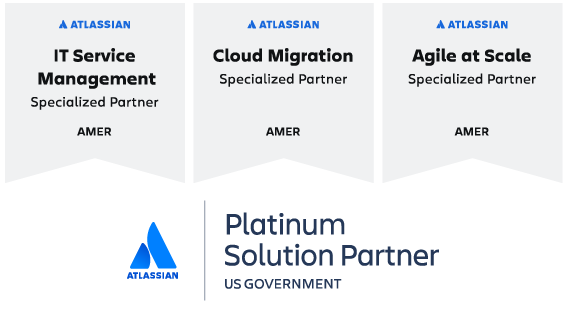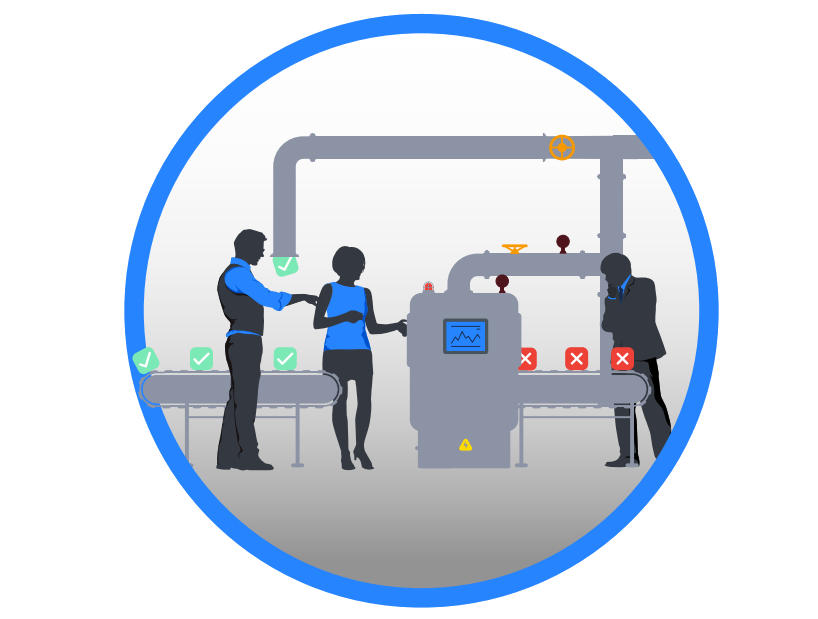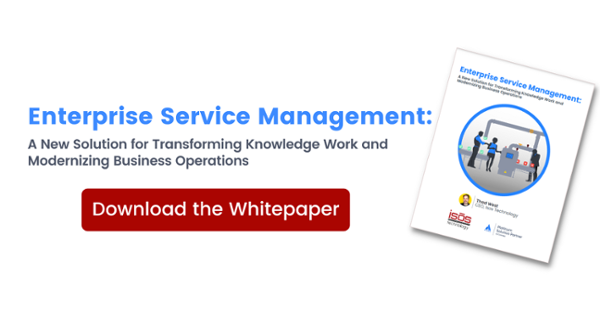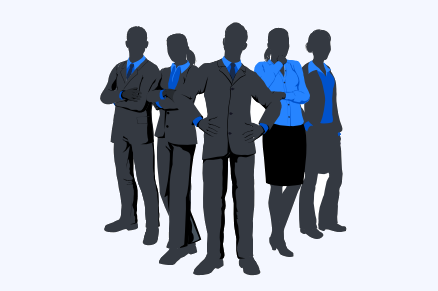How an Integrated ESM/ITSM Platform Transforms Knowledge Work and Modernizes Business Operations
How, then, can an ESM/ITSM technology platform meet these challenges? How can business teams capture and retain critical institutional and domain-focused knowledge, support asynchronous and autonomous work, improve employee experiences, and gain the transparency and efficiencies that are hallmarks of modern business operations? To answer these questions, we’ll look at some of the high-level business operations and knowledge management practices that are common across both IT teams and business teams, as well as their related challenges. Then, we’ll explore the solution-native functionality built into ESM/ITSM technology.
The Challenge: Meeting the Needs of Enterprise-Wide Business Operations and Knowledge Management Practices
Ο Initiating Work
In any given organization, virtually every division, department, and team takes in requests or initiates work in some way. If this is done in email or Slack, as is often the case, the email may go to the wrong person or the request may get lost in the shuffle. The request may be incomplete—critical details about what is needed or when it is needed may be missing—setting off a chain of back-and-forth communications, resulting in confusion and delays.
The need here is for a portal where people can submit requests of different types, and all relevant information can be captured up front.
Ο Collaboratively Executing Work
Once work is initiated, it may take place in a domain-focused point solution that is disparate from other systems. If people from cross-functional teams or people outside the company need to collaborate, they may not have access. Perhaps the workflows are rigid and do not best serve the team or customers, or address all the required steps, so parts of the work take place outside of the point solution or in other systems. Alternatively, perhaps work is executed via email or in offline documents, in which case processes may be inconsistent or completely lacking.
The need here is for a comprehensive and connected system, in which people across the company and even outside of it can collaborate in real time or asynchronously.
Ο Keeping People Updated and Informed
Throughout the lifecycle of the project, stakeholders will need to be updated on how it is progressing, and may even be asked to contribute, but they may not need to be updated on everything and may not need access to all information about the project. Status updates or collecting feedback via in-person meetings or emails are time-consuming and inefficient.
The need here is for the ability to automatically send and receive quick status updates or alerts, and for stakeholders to be able to log in when time permits, view dashboards, and explore issues in depth as needed.
Ο Capturing and Sharing Knowledge and Information
Again, each division, department, and team has institutional and domain knowledge, answers to both common and unusual questions, and insight into practices and processes. The challenge is that information typically lives in multiple places: disparate project management and domain-focused point solutions, file folder systems full of Word, Excel, and other documents (with endless versions!), and even in the minds of team members.
The need is for a knowledge base where institutional and domain-specific knowledge and processes can be documented, easily updated, and accessed by the entire team as needed. There is also a need for a wiki, where instead of submitting tickets to a portal, people can get help for common issues and answers to common questions with self-help documents and guides.
Ο Reporting and Metrics
Disparate point solutions that are not integrated, with data captured manually in spreadsheets, or not captured at all, make it harder for departments and teams to work effectively. They have difficulty getting a full understanding of what they are doing, how well they’re doing it to establish and track metrics, and reporting to upper management on roadblocks, progress, and success.
Top-level metrics might be both qualitative and quantitative, and include overall volume of work, types of requests, time to completion, and customer satisfaction. Departments can then use these metrics to identify common issues and resolve them before they occur, refine practices and processes, and even demonstrate the need for additional resources.
The need here is for a platform of integrated tools that offers a comprehensive suite of reporting capabilities so teams can easily establish metrics, get real-time insights into work in progress, and provide the right type of reporting to key stakeholders.
Ο Improving Scalability and Extensibility
Another challenge with disparate systems is integrating them so that they “talk” to one another and share information, and scaling them as enterprises inevitably grow. Building and maintaining integrations is complex and time-consuming work that places a significant burden on IT teams. Extending those individual systems, and continuing to integrate new systems as enterprises grow or add new business units through mergers and acquisitions (M&A), is even more work.
The need here is for a platform of core tools that are already integrated—a system that is designed to be extensible, with purpose-built integrations with key third-party systems, or a robust set of add-on applications. It should be straightforward to add new divisions, departments, and users as the company grows organically or through M&A.
The Solution: An Integrated Technology Platform for an End-to-End Digital Experience
Enterprise service management requires more than disparate point solutions or tools—it requires a single, integrated digital platform that serves the entire digital pipeline connecting IT, development, operations, and business teams, and even external consultants and vendors where necessary. For many organizations, an appropriate platform may already be in use by their IT, development, and/or operations teams, so it’s simply a matter of extending it to business operations.
As we mentioned earlier in this paper, there are significant advantages to leveraging the existing platform of record: it requires less of an upfront financial investment, the various tools within the platform will already be integrated, and these platforms are often designed to be integrated with other common, domain-specific point solutions. All this means there is less of a lift for IT teams to extend them to business operations teams and maintain them.
From ESM to ITSM with the Atlassian Platform
Since a large part of our consulting practice at Isos Technology is built around implementing and optimizing Atlassian tools, including using them to support enterprise agile transformation initiatives, we will speak specifically to the Atlassian platform in demonstrating how business teams can benefit from ESM/ITSM tools. The Atlassian platform is already in use in tens of thousands of IT, development, and operations teams, and is experiencing rapid adoption by business teams. A distinguishing factor of the Atlassian platform is its ability to connect the total value stream, including both the platform’s tools, and ancillary tools, and serve as a universal system of connected work. Further, its feature-rich system is capable of handling almost any use case, whether for accounting, facilities, human resources, legal, marketing, or any other business operations team.
While the Atlassian platform consists of well over a dozen solutions, and its native functionality, Marketplace apps, and integration partners continue to grow rapidly, we will primarily focus on these core products: Jira Service Management (JSM), Jira Software, Jira Work Management, and Confluence.
Following are some of the primary ways the Atlassian platform can bridge the knowledge gap and modernize business operations for teams throughout the enterprise.
Ο A Single Source of Truth Where Project Work Can Be Codified and Executed
The Atlassian platform is designed to serve as a single source of truth that connects internal and external stakeholders and enables them to collaborate and conduct work efficiently and effectively. Moving work out of emails, spreadsheets, and disparate point solutions, and into a holistic platform, means that each team can develop and codify processes, document information, execute work, and provide visibility into what they are doing to any stakeholders who need it. That information is retained in the system, so if disruption occurs, employees leave the company, or new employees join it, information continues to be accessible when and where it is needed.
This single source of truth leads to visibility, accessibility, minimization of errors, reduction of missed work, relevant notifications, and automation of work in concert, which reduces friction, supports autonomy, and speeds time to successful completion. Ultimately, this results in a better experience for both knowledge workers and customers.
Ο A Unified Portal for Project Intake
With Atlassian Jira Service Management, enterprises can set up a single, unified portal where both internal employees and external vendors and partners can go to access a catalog of requests. On the back end, each business team can leverage pre-built templates for project intake or easily build their own, ensuring that all the relevant information for each request is captured up front. This streamlines the experience for both the requestors and the teams receiving the request, saving countless hours of back-and-forth communication, speeding time to resolution, and ensuring nothing gets overlooked. It’s a better experience all around and gives teams time back that they can spend focused on higher-level work.
Ο Flexible Workflows
The Atlassian platform is incredibly flexible, so business teams are empowered to own their own processes and work in ways that best suit their needs. The tools don’t dictate the process—instead, departments and teams can self-determine how best to get work done. Although tools like Jira Service Management, Jira Software, and Jira Work Management come with hundreds of pre-built templates designed specifically for business team project intake and workflow use cases, teams can leverage them, refine them, or build their own from scratch with easy low-code/no-code tools.
Ο A Knowledge Base for Documentation and Sharing Information
Atlassian Confluence is the knowledge base tool within the Atlassian platform, and it’s a key way that enterprises can bridge the knowledge gap. With Confluence, business operations teams can document processes, information, and knowledge, and manage versions so knowledge workers are always accessing the latest information. Confluence supports functionality that allows all necessary stakeholders to view and update information. That information can be accessed via a link, eliminating the need to go digging through emails for attachments or sorting through file trees for the right document.
Ο Self-Service Capabilities
Confluence can also be used to enable self-service. Business operations teams that serve internal and external customers can document frequently asked questions and answers within Confluence. And because Confluence is fully integrated with Jira Service Management, when users come to the portal with questions, they can search for answers and resolve issues on their own, without having to submit a ticket. This speeds time to resolution, reduces friction, and creates a better customer experience—all while freeing up the business operations team to focus on higher-level work.
Ο Reporting and Metrics
Key components of the Atlassian platform—Jira Service Management, Jira Software, Jira Work Management, and Confluence—as well as many other tools within the ecosystem, all offer robust dashboard, reporting, and metrics capabilities. With these tools, not only can business operations teams get their work done more efficiently and capture and retain critical knowledge, but they can also measure it, and with those measurements, they are better positioned for continuous improvement. The tools are flexible enough that both management and teams can determine what metrics they need to capture and track, and develop customized dashboards and reports that support their continuous improvement efforts.
This also introduces a new opportunity that business teams may not have had before, especially if they were previously relying on email—the ability to account for where their time and energy are being spent, and use that data to advocate for an increase in headcount or even a restructuring to minimize work that doesn’t add value.
Ο Scalability and Extensibility
The scalability and extensibility of the Atlassian platform goes well beyond the pre-built project intake, workflow, and reporting templates made specifically for business teams. The individual solutions that comprise the Atlassian platform are designed to be used together, so the burden on IT to build and maintain integrations is significantly reduced. In addition, the Atlassian platform integrates with many common third-party enterprise solutions, as well as hundreds of Atlassian Marketplace apps to amplify functionality for specific use cases.
The platform is also designed to be used at enterprise scale, supporting tens of thousands of users, and hundreds of teams. It offers robust and straightforward functionality for adding, deleting, and managing users and teams, access and asset management, and supporting security.







